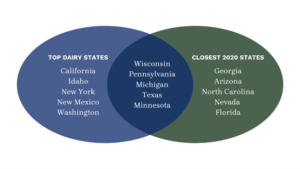 By Paul Bleiberg, Executive Vice President, Government Affairs, National Milk Producers Federation
By Paul Bleiberg, Executive Vice President, Government Affairs, National Milk Producers Federation
2024 was a tumultuous year on the political front, and 2025 promises to be just as eventful on the policy front.
The 2024 election resulted in President-elect Donald Trump winning a second term while Republicans simultaneously won control of the U.S. Senate and held their majority in the U.S. House of Representatives. With a governing trifecta in hand next year, Republicans are poised to put their stamp on many significant issues, several of which have direct implications for dairy farmers.
Picking up where this year left off, a new farm bill remains on the congressional to-do list. Lawmakers enacted a one-year extension before adjourning for the year, paving the way for House Agriculture Committee Chairman GT Thompson of Pennsylvania and incoming Senate Agriculture Committee Chairman John Boozman of Arkansas to lead their respective panels in drafting long-term farm policy legislation next year.
This year’s House and Senate farm bill frameworks included numerous dairy priorities, such as requiring USDA to conduct mandatory manufacturing cost surveys every two years, prioritizing common food name protection in trade discussions, and allowing schools to serve nutrient-dense whole milk. This year’s extension ensures that the Dairy Margin Coverage (DMC) program continues without disruption as the National Milk Producers Federation (NMPF) advocates for a new five-year farm bill next year that meets dairy’s needs.
Republicans will also turn their attention to extending the expiring provisions of the Tax Cuts and Jobs Act of 2017, one of President-elect Trump’s signature first-term accomplishments. NMPF will urge Congress to continue several pieces of the 2017 law, including the Section 199A domestic manufacturing tax deduction that allows agricultural cooperatives to pass the proceeds directly back to their farmer-owners. Congress is likely to complete this process using the tool known as budget reconciliation, which allows for the consideration of certain tax and spending legislation not subject to the Senate’s 60-vote filibuster requirement.
Finally, Congress will need to address an overall government funding deadline in early 2025. This year’s draft House and Senate agriculture funding bills included several NMPF-backed provisions, including House language to reverse the reduction in the maximum monthly milk allotment in USDA’s final foods package rule for the Special Supplemental Nutrition Program for Women, Infants, and Children (WIC) and Senate language mirroring the Innovative FEED Act to allow the Food and Drug Administration to review animal feed additives in a more efficient manner. While a short-term funding extension will require the new Congress to complete the full-year bills, the bills drafted this year will likely serve as the starting point for final negotiations next year.
Beyond these priorities, Congress and the incoming Trump Administration are likely to address major issues ranging from environmental policy to labor to trade. At each step of the way, NMPF will advocate for dairy farmers and the cooperatives they own as they seek to provide the U.S. and the world with wholesome, nutritious, and sustainably-produced milk and dairy products.
lve harmful barriers to trade, and promote the U.S. dairy industry as the global supplier of choice.
This column originally appeared in Hoard’s Dairyman Intel on Dec. 26, 2024.







